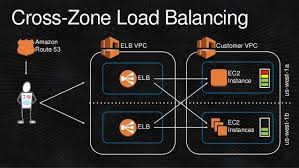AWS Cross-Zone Load Balancing
 Gedion Daniel
Gedion Daniel
Hey there! So, let’s talk about a cool feature on AWS that makes our apps faster and more reliable—AWS Cross-Zone Load Balancing. If you’ve been working with web servers and trying to balance loads across them, you know that load balancing can make or break the user experience. AWS, our friendly cloud giant, brings in Cross-Zone Load Balancing to help distribute traffic smoothly, even when we’re working with applications stretched across different availability zones. Let's dive in and get this concept down.
What is Cross-Zone Load Balancing?
Imagine you have an app that people all over Africa and beyond are using. You’ve got servers in a few regions on AWS—say, East Africa, West Africa, and Europe. Traffic is pouring in, and we want it evenly shared across servers so that no single server crashes or lags under pressure. Now, if each region (or "zone" in AWS lingo) is handling only its local traffic, some zones might get overwhelmed while others chill with minimal work. That’s where Cross-Zone Load Balancing comes in. It allows AWS Elastic Load Balancer (ELB) to spread traffic from one zone to servers in other zones, distributing the load more evenly.
In short, Cross-Zone Load Balancing lets all our zones pitch in to handle traffic from anywhere, making everything more resilient and balanced.
Why Should We Care?
Okay, so why does this matter? Here are a few reasons Cross-Zone Load Balancing is worth implementing:
Better Resource Usage: Instead of letting one region choke while another has barely any traffic, Cross-Zone Load Balancing helps balance things out. This means you can utilize all the server resources you’re paying for instead of leaving some idle.
Enhanced Reliability: If one zone goes down, other zones can still pick up the slack. So, even if AWS is having issues in, say, East Africa, your users won’t notice because West Africa and Europe zones can step in.
Improved User Experience: When your app is responsive and doesn’t lag under pressure, users are happier. And trust me, happy users keep coming back!
How Does Cross-Zone Load Balancing Work?
In AWS, we can enable Cross-Zone Load Balancing on different types of load balancers: Application Load Balancer (ALB), Network Load Balancer (NLB), and Classic Load Balancer. Here’s a quick rundown of each:
Application Load Balancer (ALB): Ideal for HTTP and HTTPS traffic. It’s the smart one, handling complex routing (like microservices or dynamic content). Cross-Zone Load Balancing here spreads traffic between all instances in different zones.
Network Load Balancer (NLB): Perfect for high-performance traffic like gaming or financial transactions. Cross-Zone Load Balancing with NLB ensures that even heavy traffic is smoothly shared across zones.
Classic Load Balancer: It’s older but still useful if you’ve got simple applications on EC2. It also supports Cross-Zone Load Balancing, but it’s best for legacy setups.
Setting Up Cross-Zone Load Balancing
Here’s the best part—it’s super easy to set up. When you’re creating or updating your load balancer, you can enable Cross-Zone Load Balancing with a single setting. Here’s a quick guide:
Go to the Load Balancers section in your AWS Management Console.
Select or create a load balancer (ALB, NLB, or Classic).
In the settings, toggle on Cross-Zone Load Balancing.
Save, and you’re good to go.
Now AWS takes over the hard work, managing traffic distribution between your instances across different zones.
Costs: What to Consider
One thing we should keep in mind is cost. AWS charges for data transferred between zones when using Cross-Zone Load Balancing on Network Load Balancers. For ALBs, there’s no extra cost, which makes it great for web apps and API-based services. Keep an eye on your bill if you’re handling a lot of cross-zone data transfer on an NLB; those costs can add up.
Real-Life Scenario: Why It Matters
Let’s say you have an e-commerce app hosted on AWS. Traffic spikes during holiday sales, and your users are from all over. With Cross-Zone Load Balancing, if one zone is overloaded, requests will flow to other zones without causing slowdowns. Your users enjoy a smooth experience, and you don’t lose out on sales because of technical hiccups. It’s the magic of seamless scaling, and honestly, it’s a lifesaver for businesses working across large user bases.
When Not to Use It
Now, Cross-Zone Load Balancing is fantastic, but not every app may need it. If your app has strict data residency requirements (where data needs to stay within a specific country or region), Cross-Zone Load Balancing might not be the best fit, as it will shift data across zones.
Also, if cost is a primary concern and you’re working with a Network Load Balancer, weigh the benefits against cross-zone data transfer costs. Sometimes, simpler setups work better for local applications.
Wrapping Up
AWS Cross-Zone Load Balancing is one of those tools that sounds technical but makes a world of difference in performance and resilience. If you’re running applications on AWS and want a solid way to handle varying traffic across regions, it’s worth setting up. It’ll keep your users happy, your resources well-used, and your app performing at its best, even under heavy load.
So, go ahead, dive into your AWS console, and give Cross-Zone Load Balancing a try. It might just be the performance boost your app needs!
Subscribe to my newsletter
Read articles from Gedion Daniel directly inside your inbox. Subscribe to the newsletter, and don't miss out.
Written by

Gedion Daniel
Gedion Daniel
I am a Software Developer from Italy.